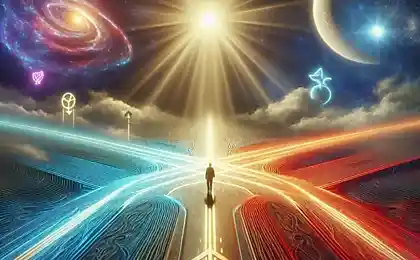646
The art of decision-making. View from the East
In the Treasury of Chinese strategic tradition, there are two pearls: Book of Changes and the game of Go. Both dedicated to decision-making. They form the basis of that method of control, which we discover by reading sun Tzu, and see, watching the developing China, South Korea and of course Japan. In my article, I will talk about, which in Asia international language strategy. In ancient times, said that this is the game of the gods. Now this is a game of top managers and presidents of corporations.Why those for whom time is the most expensive years studying the game of Go? Practice of First giving vision and strategic calculation. With their help, you have the ability to foresee though not all, but many. Playing stones Board and allow to look at events and their decision from before they become irreversible. Not everyone by nature is given a good intuition, but strategic simulation, you can learn. And teaches it for five thousand years.

(Vacy or Baduk) is a logical Board game with deep strategic content, which occurred in Ancient China, according to various estimates, from 2 to 5 thousand years ago. One of the oldest and most complex of intellectual games in the world. Is one of the five basic disciplines of the World mind games along with chess, bridge, draughts and Chinese chess Xiangqi.
In the creation myth Th says about the young heir of the ruler of Ancient China who had to prepare to manage the state. By order of his father, the sages developed for the Prince of the educational program in the form of a strategic game. Sounds very modern, isn't it? It seems that the Go game was the first in the history of the world MBA program. The tradition continues, and now the course is strategic you can go to the Moscow school of management SKOLKOVO. If to speak about the countries of the East, where the game of hundreds of years became the educational standard for the political and business elite. Before a story about the ideas Th will lead a historical example of how the strategy works.
The second world war, Western front. Bomber command is for the US and the UK a key tool for strategic attacks against the Axis. However, squadrons are big losses. How to increase the survivability of the bombers? The simplest way to reinforce the vulnerable areas of aircraft armor. Extra armour means extra weight. Fully armored bomber just does not fly. Therefore, we must understand where the main vulnerability.
With this issue, the military are turning to the mathematician Abraham Wald, who along with other scientists working in the statistical research Group at Columbia University. This organization created by the U.S. government for tackling the tasks set before the armed forces of the war. Wald – expert in statistics. He requested data on all damage that is fixed by military bombers. Processed statistical material, Wald marked areas where damage was more likely.
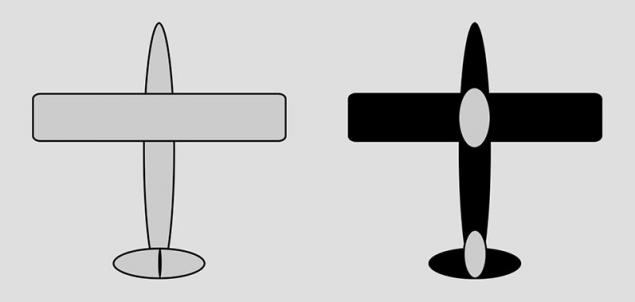
The figure shows schematically two aircraft. The first, grayed out, has no damage. On the second plane black color shaded area where military experts fix the holes. Two of the gray area is where the damage does not happen. What do you think, what solution did the scientist of the U.S. air force? Wald said, "Look for places where the surviving bombers are not damaged. It's the most vulnerable places. They returned because there was not hit." Once the aircraft returned to base, his injuries are not critical. The need to Protect the fuselage where holes the military is not seen, because these bombers were destroyed by the enemy. The method of Abraham Wald was called "survivor bias".
The Wald Approach to the problem based on the same method by which the master of Go achieve victory in the game. First, inspection. Inspection means not only the collection of information. It is important to see what cannot be seen directly. Truly, this is a key time of inspection. In the case of bombers – this is the area that received no damage and therefore was not included in the reports of the military. Only having dealt with the visible and invisible side of things, you can choose the right decision. Otherwise, the analytical picture is not complete, that will cause a chain of errors.
In the second part of the article you will be able to experience the method of examination in the search for effective solutions to Go. And now briefly about the main principles of the game and how Th helps to think and act more effectively.
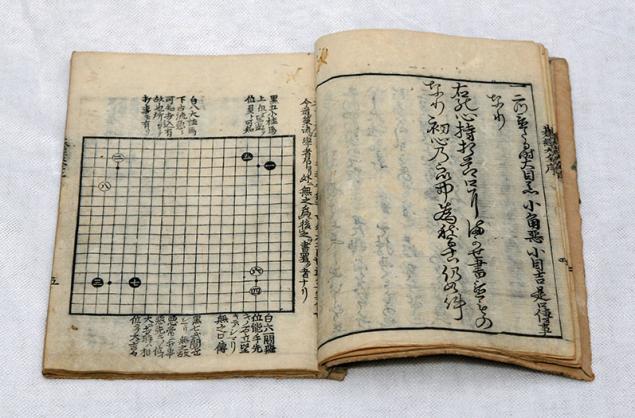
An ancient book about.
In the day when I started to write the story, died in a car accident John Nash – famous mathematician, a fan and a Nobel laureate in Economics. The American scholar, intellectual and a real crazy Nash is perhaps a typical example of the collision of the inquisitive European mind with a strange and complex Assembly of knowledge, myths and practices, which is the First in China, Japan and Korea.
Oscar in the movie "a beautiful mind" Nash played by Russell Crowe. In one scene, a young scientist trying to develop a winning strategy playing with a classmate's party in Princeton. The climax of the scene: disarmed Nash in anger, overturns the Board with stones and walking away, shouting that he does not understand why they lost, because he did everything right!
John Nash really carried away with the game while studying and working at Princeton University. Subsequently, the scientist will propose a new approach to the description of the players ' choices, but on the playing field of business, which is known in game theory as the "Nash equilibrium". According to him, the players end the game can use the optimal strategy. They allow them to reach the non-cooperative equilibrium. We are talking about the opposition, whose cooperation is not due.
Th is one of the most popular games in the world. In 2000 there were 27 million people playing, that is on average 222 on the planet had one player Go. 22 million players (that is, over 80% of the total) – the inhabitants of Eastern Asia.
According to the model of Nash, even the opponents will strive to maintain the balance achieved, so any change will not improve the position of each. Moreover, it is possible to find such a balance, which will benefit not just one player, and all the participants of the game. In other words, competition doesn't mean you necessarily lose when the other goes positive. Let others earn and you can earn yourself. The Nash equilibrium can be achieved in any type of game, as in mutually beneficial and in the zero-sum game in which the acquisition of one means the loss of another. And what game we will play, depends on us.
The idea that the competition in the black can be all the players, it seems strange to the Western mind, accustomed to think of "chess logic": either we them or they us. However, this idea is known since the times of Lao Tzu and finds its embodiment not only in Economics but also in the world around us. Just look around.
Professor of Kyoto University Kindzi, Imanishi a schoolboy he was fond of collecting specimens collected in the Japanese mountains, and in the evenings studied the game of Go. Growing up, he became an environmentalist and developed the theory of Sumi Jo Wake (segmentation of habitats). In the vicinity of the Kamogawa river in Kyoto he found four one-day butterflies. Insects formed a separate colony, organized in accordance with the velocity of the river. Based on this observation, he concluded that the types exist and survive with the help of a harmonious division of ecological space, not struggle. An ecosystem or a society in which every man for himself and all against all, doomed. On the contrary, if together everyone achieve harmony, everyone gets the niche on hold which he has enough abilities and resources.
Perhaps John Nash found in, the idea of a balance of competing forces. After all, the point of the game is that black and white stones competing to coexist by keeping balance, sharing with each other the space of the game Board.
The size of the field Go – 19x19 intersections. In sum 361 game, each of which in the course of the game can be supplied black or white stone. Game rocks only differ in color, form all the same. The goal is the division of the territories. The winner is the one who possessed the greatest part of the playing field. A consequence of the large dimension – the impossibility of complete enumeration options (for comparison: the chess field 8x8 cells). As in reality, we cannot calculate all the possible consequences of our decisions, which enables man to beat in Th the most advanced computer programs.

One of the reasons for the complexity of Go is an incredibly large variety of possible combinations, which is estimated as ten in the hundred and seventieth degree (10170 ). How big is this number? Judge for yourself: even the number of atoms that comprise the entire visible universe, disproportionately less – "only" 1081. By the way, the number of possible unique chess games is approximately 10118.
What laws are living stones and that they get in the game? The stones are introduced into the game one at a time. Put on Board a stone cannot be moved. It can be removed from the Board only if they're surrounded by and take prisoner other people's stones.
The "life" of stones depends on their strength, which determines the number of open connections with empty intersections around. Each link provides an additional degree of freedom and direction for development. Figure 1 the black stone crosses marked the four neighboring intersections, and the white only three. More external links – more features. Counts as direct communication along the grid lines. Diagonal ties.

The stones of the same color are combined into a single circuit, taking the total degrees of freedom. Considering figure 2, we can say that the black organization has grown and now occupies two crossroads. But it is a single organism, connectivity with the environment is equal to six.
Stones of opposite colors are in the close contact Rob each other's degrees of freedom and therefore become weaker. The black and white, standing closely in figure 3, three connections with the surrounding grid. When a stone or a chain of multiple stones gets into the environment, they begin to lose degrees of freedom. Having lost the last connection with the playing field, the encirclement out of the game and go to the category of prisoners. As it is shown in figures 4 and 5. The numbers indicate the sequence of plays in the game. Black stones purposefully surround two white. If the player in white will decide to pass them, the black surround white and will remove them from the Board, spending six of their stones. The result of the capture is shown in figure 6. Could white escape and get out of the environment? It's enough to build a chain of white, increasing the number of connections with the outside world. The answer to the question of whether that makes sense depends on the situation.

The goal, of course, is to hunt for other people's stones. It is a means of persuasion that this is our land. The task to organize a system of their stones so that they possessed and held more territory than it will be under the control of the opponent. What does it mean to master a territory? It means to surround her with stones so that the game on this site for a competitor will become meaningless. All its stones are guaranteed to be surrounded and taken out. In other words, to master – means to establish its sovereignty.
At the initial stage to successfully play Go, enough to be able to count to four, exposing weaknesses in their own and other circuits, where the coherence is below this figure (4). These weak areas are key locations for management by other organizations of the stones.
When the strategist wants to change something in the event or process, it looks for a key part and acts on it. The example of Abraham Wald shows that such a link can be invisible to standard analyses. As practice shows, an adult with difficulty and considers it to four. And the child can't control even situations where it is necessary to consider only one to find the stones with one degree of freedom. Attention deficit disorder is a disease of modern man.
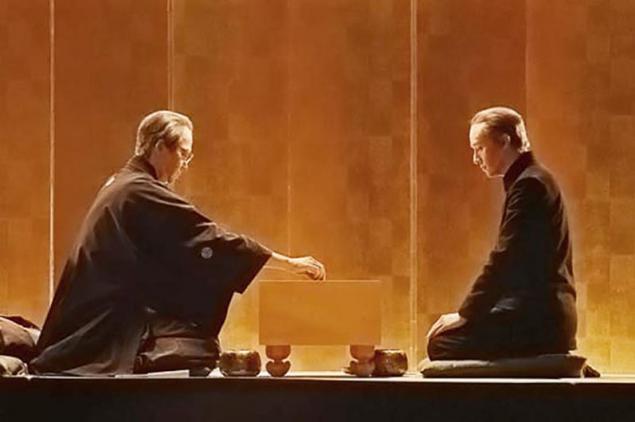
Among the many Board games, distinguished by the fact that it was the most difficult for a computer. Whereas the strongest chess programs are superior to the strength of the strongest players in the world, Go even the best of programs significantly weaker medium playing lovers. At the moment the most successful in the game against a qualified person program MoGoTitan twice played with a Korean professional Kim Myungwan. In the first game, 7 Aug 2008, 9 handicap stones, MoGoTitan won with an advantage of 1.5 points. Thinking of moves DIRECT used 55 minutes people – only 13. However, in the comments, Kim said that if he used more time, it would not affect the result, and assessed the playing strength of MOGO 2-3 Dan. In the second game, produced on 20 September 2008, at 7 handicap stones, MOGO gave up on the 263-meter run. While MoGoTitan worked on a supercomputer with a capacity of 15 teraflops – more than 1,000 times more powerful than Deep blue, which won in 1997, world chess champion Garry Kasparov.
Is there something more than pure logic in making decisions, if a person is able to solve strategic tasks more efficient supercomputer that we see in the case? Exploring the practical aspects of the game, it is easy to verify that the basis of competent solutions is the perception. The cause of the error is also likely to be perception. The purely logical mistakes man makes a not so often. Malcolm Gladwell in his book "Inspiration. The power of instant solutions" vividly described how the perception drowns out not only the arguments of reason, but even professional experience. Or Vice versa, gives a hint where the mind passes.
Perception not only affects decision-making. It depends on our success. Do not believe? Then meet with Professor Richard Wiseman from University of Hertfordshire.
Within ten years, Wiseman followed the lives of four hundred subjects of different ages and professions. He found them through an ad in the Newspapers, in which he asked to contact him to those people who think of yourself as a spoiled child, or total losers. They kept a diary and ran the tests, as well as Wiseman described his life in interviews and reports.
In one study, he asked subjects to view a newspaper and count the number of illustrations in it. People who considered themselves losers, spent on this task for a few minutes. People who considered themselves lucky, took an average of a few seconds. Here is how he describes the results of the experiment:
"In this newspaper on the second page is half a page typed ad: Stop to consider: in this paper, exactly 43 photos. This ad was impossible to miss, however, the losers, obsessed with counting, do not pay attention to him. Another time I repeated the task, but the ad posted by: Stop counting, inform the Professor that you read it and you will get $ 250. The effect was the same. "Lucky" got the money, and the losers left with their failure. This experiment showed that people who consider themselves losers, more tense, than their successful counterparts, and that tension often prevents them to notice something unexpected, but useful."
Weissman argues that what we call luck is actually just a consequence of our behavior, which brings together the style perception and handling of events and people we meet on life's journey. The "losers" too narrow a focus. "Lucky" says it all. As a result, he could not find quite what I was looking for, but the fact that it is more appropriate.
So then what can be concluded? As in the case of Abraham Wald, the key to finding effective solutions is our perception, the ability to look beyond, to see the unseen, read between the lines and, of course, to think creatively. I now invite the reader to test this ability on strategic objective from the game. The solution of such problems is not only entertaining part of the game, but also good training for those who develop the qualities of a strategist.
Look at figures 7 and 8. Which of them, in your opinion, five stones arranged more effectively? To choose, one must understand the difference between the two structures. Disassembled above the rules enough to solve this problem.
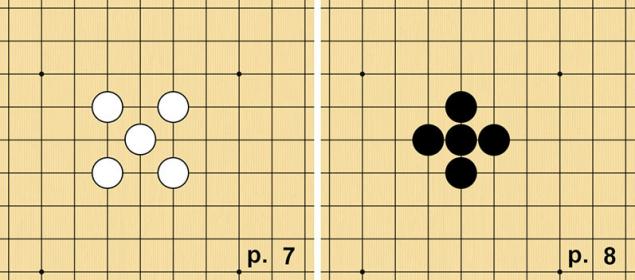
The main difference between whites and blacks – in type connection of structural elements. White connected to each other indirectly, and black is right. This means that five black form an indivisible structure in which all elements are fused together. White each piece stands apart from the next. So black it is impossible to divide because between black can not put a white stone and black to push the rules. White is theoretically possible to break apart.
A key criterion of the organization, available to us now is connectivity with the external environment. It is obvious that the physical footprint is equal to: five intersections under stones. But there is also an adjacent empty intersections on which to continue expansion. We have already calculated these relationships at the stones in figures 2 and 3. The more external links, the stronger the organization and the more prospects for development. So, believe.
Black has eight connections (figure 9). They are marked with crosses. Again, that counts only those intersections that are connected by lines with the spots which are already black stones. Diagonal does not count. That's why I said that the white stones in figure 7 are not connected to each other. They are on the diagonals. Now calculate the when white.
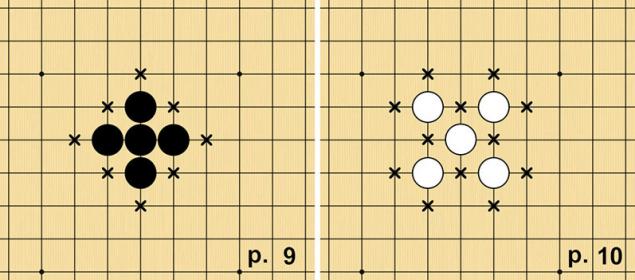
It is seen that the connectivity of white – twelve ties for the same five stones (figure 10). So what is the organization effective? Black elements are fused, as in a Corporation with a linear structure and tight control. White organized on a network basis, so each element has additional degrees of freedom.
This seemingly simple example is of direct relevance to the strategy. A good illustration of the Prussian military machine, which evolved from fusion organizations such as the conglomerate of black stones to organizations with high internal freedom. The famous army of Frederick the Great could fight only as a whole and under strict control. It could not send a detachment of soldiers on a mission, since they would have immediately fled. "The most puzzling to me, – said once Frederick is close to the General, is our security is among our camp." A good feature for a private army, isn't it?
A military organization, built in the NINETEENTH century by two Prussian generals Moltke (senior and Junior), in contrast, was based on the principle of delegation of responsibility to officers. This relieved the war machine too much at one, made it flexible and unique in its kind, which eventually brought Germany into the strongest military powers of Europe.
If you look from this angle on the business community, we see that opaque, monolithic structure, with blurred responsibility and total control lose companies built on the principles of inner freedom, delegation of responsibility and openness. This pattern is recorded in the "Tao te Ching" in the formula "Strong and solid dying, weak and flexible lives."
Another way to study is to try to optimize the organization. Let's remove some of the stones and will see how to change the connectivity of the entire system. With white it's simple. If you remove any of the four outer stones, then the connectivity drops to 10 intersections (figure 11). When you remove the Central element (figure 12) connectivity will not change, but the organization will lose one visible property.
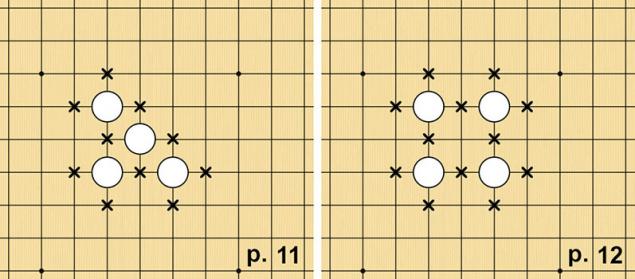
If the black stone suddenly turns white between the three (figure 13), it can be easy to surround and shoot. Figure 14 shows the result of this. The same happens when you try black to take the intersections A, b and C. This means that these sites actually belong to white although not the busy stones. Black is pointless to go there. But remove the Central white stone, and you will see that catch black won't be so easy. In other words, white has no extra stones in the organization. Now let's see if we can optimize black. See figures 15 and 16.Removal of any of the four external links in the black chain does not reduce the coherence. It is also equal to eight. This in itself is interesting. It turns out that these stones do not affect the number of links they have or not. But they have, and that means that these stones loafers that became overhead cost of the player. A logical situation for your organization, is built in a similar linear fashion.
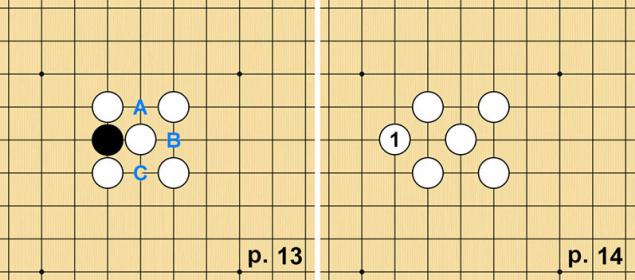
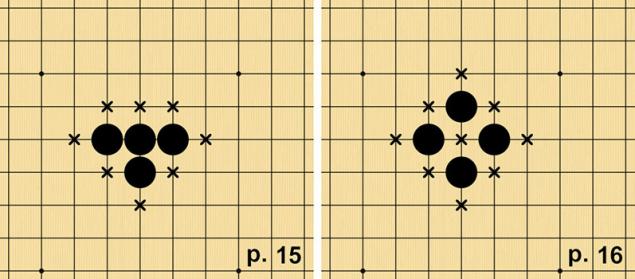
But if we delete the Central element, then the connectivity will increase to nine! It is easy to assume that the organization grew up just around this Central stone is consistently expanding in four directions. However, an inefficient management model has led to the fact that this Central item has become a burden for black, not key link, as is the case with white. And this was to be expected!
Now imagine you need to scale the organization to take the intersection A (figures 17 and 18). Whites will not be difficult to do. What about black people?

Black will have to add five stones to get to the desired location (figure 19). Attempt to optimize the process (figure 20) will lead to disruption in the organization: between black gap appears, which is unacceptable to their linear structure.
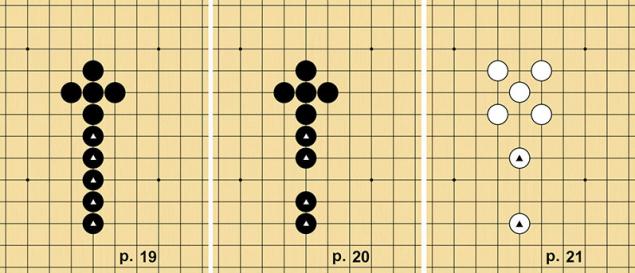
White good management enough two marked stones (figure 21). Their work will be enough to support the communication between all parts of white organizations. Saving resources and distributing them correctly in the best areas of the Board, the player will easily outperform white players for black, if the latter is to build linear and non-network management chain.
What can you advise to the player who chose a strategy of black? In Th there is a graceful solution: do not load! That is, avoid preconcentration effort, control and management. The format does not allow me to elaborate on this and other smart solutions. Nine of them are described in our by Igor Grishin the book "the Martial art of strategy. Russian style. Nine elegant solutions" that I recommend to the interested reader.
In Th there are several systems of rating the strength of the players. One of the most common Japanese rank system similar to used in the martial arts. New players receive a rank of 25-30 Kyu. 30 Kyu corresponds to the level of the player who learned the rules but not yet played a single game. As the player becomes stronger, its rank decreases. Usually at the initial stages of learning takes place quickly and most reach 8-12 Kyu in a few months. Players exceeding the one Kyu grade, receive the rank of 1 Dan. With further increase of skills, the grade given is growing, unlike Kyu. Traditional limit – 9 is given, which gives a true master. There is also the concept of "10th Dan", but it is not the rank indicating the skill of the player, and one of the titles. By definition, the difference between adjacent ranks is equal to one handicap stone, that is, theoretically, the 8 Kyu player will have equal chances of winning with player 5 Kyu, if you take a 3 stone handicap.
Instead of conclusion I will quote a great Russian entrepreneur Sergei Andreev, President of the group of companies of ABBYY: "teaches you to see things that most people released from sight. To win, you need to see the balance of power to see weaknesses, like your own, to see the error. The nature of the weaknesses and errors, and indeed the balance of Go is unique in that it can and should be relayed in our life and work. Recognizing their mistakes on the Board, you learn to see your mistakes in life and work. When you learn strategy, you learn the strategy to life."
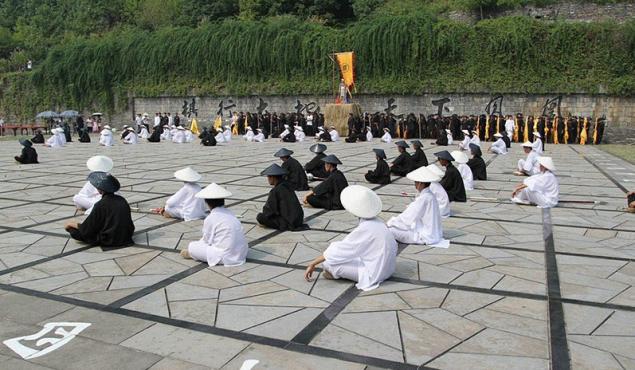
Sometimes the stones are the real people.
Quotes by famous people about the game Go:
Mao Zedong: "Wazy (Th) is the only game where everyone starts with an empty Board and no additional conditions, and everything that happens next depends on the quality of your mind... War is like vazy... When the enemy is stronger, we need to find such moves to dominate the whole space of the Board".
Edward Lasker, chess grandmaster and popularizer of the game of Go, a relative of Emanuel Lasker: "while the Baroque rules of chess could only be created by people, the rules are so simple, elegant and extremely logical that if somewhere in the Universe there are intelligent life forms, these creatures should play Go".
John reed, the former head of Citicorp: "Competition similar to wise positioning over time, but not the crush of competing products on the market. I prefer competition in the style of a Chinese Board game called Go. You see where other players have placed their stones and decide where to put their".
Piet hut, an astrophysicist at the Institute for advanced study in Princeton: "it may Be that it would take hundreds of years before a computer would defeat a human at Go. It'll probably happen sooner. But if a man of ordinary intellectual baggage will be devoted to reading the game of Go a few months, he will be able to beat the existing game program. You don't need to be Kasparov".
Hans Berliner, world champion in correspondence chess: "Chess is now losing its place intellectual pursuits of excellence. Smart people in search of a decent Board game can try the game Go".
Those Tikkun, 9 Dan in Go, one of the strongest Go players in the world: "Study the game of Go is a wonderful way to develop both creative and logical abilities of the child, because the game will use both hemispheres of the brain."
Henry Kissinger: "Chess give only two outcomes: draw and checkmate. The goal is total victory or defeat, and the battle is in the forehead, in the center of the Board. Go, on the contrary, the objective is to obtain a relative advantage; the game is played across the Board, and the purpose of the action is to increase capacity and to reduce the enemy's ability. The purpose of Go is to a lesser extent win, rather, ongoing strategic progress."
The game of Go studied in military academies of China and Korea. It is played by prominent politicians and heads of the largest corporations in the world. Fans of the game can be found in the most unexpected places. The Internet is laid out sufficiently large number fotografii showing how people are playing Go on the Arctic ice floes, on the tops of the highest mountains, among the Sands of the Sahara and even under water, dressed in diving equipment. published
P. S. And remember, only by changing their consumption — together we change the world! ©
Join us in Facebook and in Vkontakte, and we're Classmates
Source: erazvitie.org/article/iskusstvo__prinjatija__reshnij._vzgljad_s_vostoka

(Vacy or Baduk) is a logical Board game with deep strategic content, which occurred in Ancient China, according to various estimates, from 2 to 5 thousand years ago. One of the oldest and most complex of intellectual games in the world. Is one of the five basic disciplines of the World mind games along with chess, bridge, draughts and Chinese chess Xiangqi.
In the creation myth Th says about the young heir of the ruler of Ancient China who had to prepare to manage the state. By order of his father, the sages developed for the Prince of the educational program in the form of a strategic game. Sounds very modern, isn't it? It seems that the Go game was the first in the history of the world MBA program. The tradition continues, and now the course is strategic you can go to the Moscow school of management SKOLKOVO. If to speak about the countries of the East, where the game of hundreds of years became the educational standard for the political and business elite. Before a story about the ideas Th will lead a historical example of how the strategy works.
The second world war, Western front. Bomber command is for the US and the UK a key tool for strategic attacks against the Axis. However, squadrons are big losses. How to increase the survivability of the bombers? The simplest way to reinforce the vulnerable areas of aircraft armor. Extra armour means extra weight. Fully armored bomber just does not fly. Therefore, we must understand where the main vulnerability.
With this issue, the military are turning to the mathematician Abraham Wald, who along with other scientists working in the statistical research Group at Columbia University. This organization created by the U.S. government for tackling the tasks set before the armed forces of the war. Wald – expert in statistics. He requested data on all damage that is fixed by military bombers. Processed statistical material, Wald marked areas where damage was more likely.

The figure shows schematically two aircraft. The first, grayed out, has no damage. On the second plane black color shaded area where military experts fix the holes. Two of the gray area is where the damage does not happen. What do you think, what solution did the scientist of the U.S. air force? Wald said, "Look for places where the surviving bombers are not damaged. It's the most vulnerable places. They returned because there was not hit." Once the aircraft returned to base, his injuries are not critical. The need to Protect the fuselage where holes the military is not seen, because these bombers were destroyed by the enemy. The method of Abraham Wald was called "survivor bias".
The Wald Approach to the problem based on the same method by which the master of Go achieve victory in the game. First, inspection. Inspection means not only the collection of information. It is important to see what cannot be seen directly. Truly, this is a key time of inspection. In the case of bombers – this is the area that received no damage and therefore was not included in the reports of the military. Only having dealt with the visible and invisible side of things, you can choose the right decision. Otherwise, the analytical picture is not complete, that will cause a chain of errors.
In the second part of the article you will be able to experience the method of examination in the search for effective solutions to Go. And now briefly about the main principles of the game and how Th helps to think and act more effectively.

An ancient book about.
In the day when I started to write the story, died in a car accident John Nash – famous mathematician, a fan and a Nobel laureate in Economics. The American scholar, intellectual and a real crazy Nash is perhaps a typical example of the collision of the inquisitive European mind with a strange and complex Assembly of knowledge, myths and practices, which is the First in China, Japan and Korea.
Oscar in the movie "a beautiful mind" Nash played by Russell Crowe. In one scene, a young scientist trying to develop a winning strategy playing with a classmate's party in Princeton. The climax of the scene: disarmed Nash in anger, overturns the Board with stones and walking away, shouting that he does not understand why they lost, because he did everything right!
John Nash really carried away with the game while studying and working at Princeton University. Subsequently, the scientist will propose a new approach to the description of the players ' choices, but on the playing field of business, which is known in game theory as the "Nash equilibrium". According to him, the players end the game can use the optimal strategy. They allow them to reach the non-cooperative equilibrium. We are talking about the opposition, whose cooperation is not due.
Th is one of the most popular games in the world. In 2000 there were 27 million people playing, that is on average 222 on the planet had one player Go. 22 million players (that is, over 80% of the total) – the inhabitants of Eastern Asia.
According to the model of Nash, even the opponents will strive to maintain the balance achieved, so any change will not improve the position of each. Moreover, it is possible to find such a balance, which will benefit not just one player, and all the participants of the game. In other words, competition doesn't mean you necessarily lose when the other goes positive. Let others earn and you can earn yourself. The Nash equilibrium can be achieved in any type of game, as in mutually beneficial and in the zero-sum game in which the acquisition of one means the loss of another. And what game we will play, depends on us.
The idea that the competition in the black can be all the players, it seems strange to the Western mind, accustomed to think of "chess logic": either we them or they us. However, this idea is known since the times of Lao Tzu and finds its embodiment not only in Economics but also in the world around us. Just look around.
Professor of Kyoto University Kindzi, Imanishi a schoolboy he was fond of collecting specimens collected in the Japanese mountains, and in the evenings studied the game of Go. Growing up, he became an environmentalist and developed the theory of Sumi Jo Wake (segmentation of habitats). In the vicinity of the Kamogawa river in Kyoto he found four one-day butterflies. Insects formed a separate colony, organized in accordance with the velocity of the river. Based on this observation, he concluded that the types exist and survive with the help of a harmonious division of ecological space, not struggle. An ecosystem or a society in which every man for himself and all against all, doomed. On the contrary, if together everyone achieve harmony, everyone gets the niche on hold which he has enough abilities and resources.
Perhaps John Nash found in, the idea of a balance of competing forces. After all, the point of the game is that black and white stones competing to coexist by keeping balance, sharing with each other the space of the game Board.
The size of the field Go – 19x19 intersections. In sum 361 game, each of which in the course of the game can be supplied black or white stone. Game rocks only differ in color, form all the same. The goal is the division of the territories. The winner is the one who possessed the greatest part of the playing field. A consequence of the large dimension – the impossibility of complete enumeration options (for comparison: the chess field 8x8 cells). As in reality, we cannot calculate all the possible consequences of our decisions, which enables man to beat in Th the most advanced computer programs.

One of the reasons for the complexity of Go is an incredibly large variety of possible combinations, which is estimated as ten in the hundred and seventieth degree (10170 ). How big is this number? Judge for yourself: even the number of atoms that comprise the entire visible universe, disproportionately less – "only" 1081. By the way, the number of possible unique chess games is approximately 10118.
What laws are living stones and that they get in the game? The stones are introduced into the game one at a time. Put on Board a stone cannot be moved. It can be removed from the Board only if they're surrounded by and take prisoner other people's stones.
The "life" of stones depends on their strength, which determines the number of open connections with empty intersections around. Each link provides an additional degree of freedom and direction for development. Figure 1 the black stone crosses marked the four neighboring intersections, and the white only three. More external links – more features. Counts as direct communication along the grid lines. Diagonal ties.

The stones of the same color are combined into a single circuit, taking the total degrees of freedom. Considering figure 2, we can say that the black organization has grown and now occupies two crossroads. But it is a single organism, connectivity with the environment is equal to six.
Stones of opposite colors are in the close contact Rob each other's degrees of freedom and therefore become weaker. The black and white, standing closely in figure 3, three connections with the surrounding grid. When a stone or a chain of multiple stones gets into the environment, they begin to lose degrees of freedom. Having lost the last connection with the playing field, the encirclement out of the game and go to the category of prisoners. As it is shown in figures 4 and 5. The numbers indicate the sequence of plays in the game. Black stones purposefully surround two white. If the player in white will decide to pass them, the black surround white and will remove them from the Board, spending six of their stones. The result of the capture is shown in figure 6. Could white escape and get out of the environment? It's enough to build a chain of white, increasing the number of connections with the outside world. The answer to the question of whether that makes sense depends on the situation.

The goal, of course, is to hunt for other people's stones. It is a means of persuasion that this is our land. The task to organize a system of their stones so that they possessed and held more territory than it will be under the control of the opponent. What does it mean to master a territory? It means to surround her with stones so that the game on this site for a competitor will become meaningless. All its stones are guaranteed to be surrounded and taken out. In other words, to master – means to establish its sovereignty.
At the initial stage to successfully play Go, enough to be able to count to four, exposing weaknesses in their own and other circuits, where the coherence is below this figure (4). These weak areas are key locations for management by other organizations of the stones.
When the strategist wants to change something in the event or process, it looks for a key part and acts on it. The example of Abraham Wald shows that such a link can be invisible to standard analyses. As practice shows, an adult with difficulty and considers it to four. And the child can't control even situations where it is necessary to consider only one to find the stones with one degree of freedom. Attention deficit disorder is a disease of modern man.

Among the many Board games, distinguished by the fact that it was the most difficult for a computer. Whereas the strongest chess programs are superior to the strength of the strongest players in the world, Go even the best of programs significantly weaker medium playing lovers. At the moment the most successful in the game against a qualified person program MoGoTitan twice played with a Korean professional Kim Myungwan. In the first game, 7 Aug 2008, 9 handicap stones, MoGoTitan won with an advantage of 1.5 points. Thinking of moves DIRECT used 55 minutes people – only 13. However, in the comments, Kim said that if he used more time, it would not affect the result, and assessed the playing strength of MOGO 2-3 Dan. In the second game, produced on 20 September 2008, at 7 handicap stones, MOGO gave up on the 263-meter run. While MoGoTitan worked on a supercomputer with a capacity of 15 teraflops – more than 1,000 times more powerful than Deep blue, which won in 1997, world chess champion Garry Kasparov.
Is there something more than pure logic in making decisions, if a person is able to solve strategic tasks more efficient supercomputer that we see in the case? Exploring the practical aspects of the game, it is easy to verify that the basis of competent solutions is the perception. The cause of the error is also likely to be perception. The purely logical mistakes man makes a not so often. Malcolm Gladwell in his book "Inspiration. The power of instant solutions" vividly described how the perception drowns out not only the arguments of reason, but even professional experience. Or Vice versa, gives a hint where the mind passes.
Perception not only affects decision-making. It depends on our success. Do not believe? Then meet with Professor Richard Wiseman from University of Hertfordshire.
Within ten years, Wiseman followed the lives of four hundred subjects of different ages and professions. He found them through an ad in the Newspapers, in which he asked to contact him to those people who think of yourself as a spoiled child, or total losers. They kept a diary and ran the tests, as well as Wiseman described his life in interviews and reports.
In one study, he asked subjects to view a newspaper and count the number of illustrations in it. People who considered themselves losers, spent on this task for a few minutes. People who considered themselves lucky, took an average of a few seconds. Here is how he describes the results of the experiment:
"In this newspaper on the second page is half a page typed ad: Stop to consider: in this paper, exactly 43 photos. This ad was impossible to miss, however, the losers, obsessed with counting, do not pay attention to him. Another time I repeated the task, but the ad posted by: Stop counting, inform the Professor that you read it and you will get $ 250. The effect was the same. "Lucky" got the money, and the losers left with their failure. This experiment showed that people who consider themselves losers, more tense, than their successful counterparts, and that tension often prevents them to notice something unexpected, but useful."
Weissman argues that what we call luck is actually just a consequence of our behavior, which brings together the style perception and handling of events and people we meet on life's journey. The "losers" too narrow a focus. "Lucky" says it all. As a result, he could not find quite what I was looking for, but the fact that it is more appropriate.
So then what can be concluded? As in the case of Abraham Wald, the key to finding effective solutions is our perception, the ability to look beyond, to see the unseen, read between the lines and, of course, to think creatively. I now invite the reader to test this ability on strategic objective from the game. The solution of such problems is not only entertaining part of the game, but also good training for those who develop the qualities of a strategist.
Look at figures 7 and 8. Which of them, in your opinion, five stones arranged more effectively? To choose, one must understand the difference between the two structures. Disassembled above the rules enough to solve this problem.

The main difference between whites and blacks – in type connection of structural elements. White connected to each other indirectly, and black is right. This means that five black form an indivisible structure in which all elements are fused together. White each piece stands apart from the next. So black it is impossible to divide because between black can not put a white stone and black to push the rules. White is theoretically possible to break apart.
A key criterion of the organization, available to us now is connectivity with the external environment. It is obvious that the physical footprint is equal to: five intersections under stones. But there is also an adjacent empty intersections on which to continue expansion. We have already calculated these relationships at the stones in figures 2 and 3. The more external links, the stronger the organization and the more prospects for development. So, believe.
Black has eight connections (figure 9). They are marked with crosses. Again, that counts only those intersections that are connected by lines with the spots which are already black stones. Diagonal does not count. That's why I said that the white stones in figure 7 are not connected to each other. They are on the diagonals. Now calculate the when white.

It is seen that the connectivity of white – twelve ties for the same five stones (figure 10). So what is the organization effective? Black elements are fused, as in a Corporation with a linear structure and tight control. White organized on a network basis, so each element has additional degrees of freedom.
This seemingly simple example is of direct relevance to the strategy. A good illustration of the Prussian military machine, which evolved from fusion organizations such as the conglomerate of black stones to organizations with high internal freedom. The famous army of Frederick the Great could fight only as a whole and under strict control. It could not send a detachment of soldiers on a mission, since they would have immediately fled. "The most puzzling to me, – said once Frederick is close to the General, is our security is among our camp." A good feature for a private army, isn't it?
A military organization, built in the NINETEENTH century by two Prussian generals Moltke (senior and Junior), in contrast, was based on the principle of delegation of responsibility to officers. This relieved the war machine too much at one, made it flexible and unique in its kind, which eventually brought Germany into the strongest military powers of Europe.
If you look from this angle on the business community, we see that opaque, monolithic structure, with blurred responsibility and total control lose companies built on the principles of inner freedom, delegation of responsibility and openness. This pattern is recorded in the "Tao te Ching" in the formula "Strong and solid dying, weak and flexible lives."
Another way to study is to try to optimize the organization. Let's remove some of the stones and will see how to change the connectivity of the entire system. With white it's simple. If you remove any of the four outer stones, then the connectivity drops to 10 intersections (figure 11). When you remove the Central element (figure 12) connectivity will not change, but the organization will lose one visible property.

If the black stone suddenly turns white between the three (figure 13), it can be easy to surround and shoot. Figure 14 shows the result of this. The same happens when you try black to take the intersections A, b and C. This means that these sites actually belong to white although not the busy stones. Black is pointless to go there. But remove the Central white stone, and you will see that catch black won't be so easy. In other words, white has no extra stones in the organization. Now let's see if we can optimize black. See figures 15 and 16.Removal of any of the four external links in the black chain does not reduce the coherence. It is also equal to eight. This in itself is interesting. It turns out that these stones do not affect the number of links they have or not. But they have, and that means that these stones loafers that became overhead cost of the player. A logical situation for your organization, is built in a similar linear fashion.


But if we delete the Central element, then the connectivity will increase to nine! It is easy to assume that the organization grew up just around this Central stone is consistently expanding in four directions. However, an inefficient management model has led to the fact that this Central item has become a burden for black, not key link, as is the case with white. And this was to be expected!
Now imagine you need to scale the organization to take the intersection A (figures 17 and 18). Whites will not be difficult to do. What about black people?

Black will have to add five stones to get to the desired location (figure 19). Attempt to optimize the process (figure 20) will lead to disruption in the organization: between black gap appears, which is unacceptable to their linear structure.

White good management enough two marked stones (figure 21). Their work will be enough to support the communication between all parts of white organizations. Saving resources and distributing them correctly in the best areas of the Board, the player will easily outperform white players for black, if the latter is to build linear and non-network management chain.
What can you advise to the player who chose a strategy of black? In Th there is a graceful solution: do not load! That is, avoid preconcentration effort, control and management. The format does not allow me to elaborate on this and other smart solutions. Nine of them are described in our by Igor Grishin the book "the Martial art of strategy. Russian style. Nine elegant solutions" that I recommend to the interested reader.
In Th there are several systems of rating the strength of the players. One of the most common Japanese rank system similar to used in the martial arts. New players receive a rank of 25-30 Kyu. 30 Kyu corresponds to the level of the player who learned the rules but not yet played a single game. As the player becomes stronger, its rank decreases. Usually at the initial stages of learning takes place quickly and most reach 8-12 Kyu in a few months. Players exceeding the one Kyu grade, receive the rank of 1 Dan. With further increase of skills, the grade given is growing, unlike Kyu. Traditional limit – 9 is given, which gives a true master. There is also the concept of "10th Dan", but it is not the rank indicating the skill of the player, and one of the titles. By definition, the difference between adjacent ranks is equal to one handicap stone, that is, theoretically, the 8 Kyu player will have equal chances of winning with player 5 Kyu, if you take a 3 stone handicap.
Instead of conclusion I will quote a great Russian entrepreneur Sergei Andreev, President of the group of companies of ABBYY: "teaches you to see things that most people released from sight. To win, you need to see the balance of power to see weaknesses, like your own, to see the error. The nature of the weaknesses and errors, and indeed the balance of Go is unique in that it can and should be relayed in our life and work. Recognizing their mistakes on the Board, you learn to see your mistakes in life and work. When you learn strategy, you learn the strategy to life."

Sometimes the stones are the real people.
Quotes by famous people about the game Go:
Mao Zedong: "Wazy (Th) is the only game where everyone starts with an empty Board and no additional conditions, and everything that happens next depends on the quality of your mind... War is like vazy... When the enemy is stronger, we need to find such moves to dominate the whole space of the Board".
Edward Lasker, chess grandmaster and popularizer of the game of Go, a relative of Emanuel Lasker: "while the Baroque rules of chess could only be created by people, the rules are so simple, elegant and extremely logical that if somewhere in the Universe there are intelligent life forms, these creatures should play Go".
John reed, the former head of Citicorp: "Competition similar to wise positioning over time, but not the crush of competing products on the market. I prefer competition in the style of a Chinese Board game called Go. You see where other players have placed their stones and decide where to put their".
Piet hut, an astrophysicist at the Institute for advanced study in Princeton: "it may Be that it would take hundreds of years before a computer would defeat a human at Go. It'll probably happen sooner. But if a man of ordinary intellectual baggage will be devoted to reading the game of Go a few months, he will be able to beat the existing game program. You don't need to be Kasparov".
Hans Berliner, world champion in correspondence chess: "Chess is now losing its place intellectual pursuits of excellence. Smart people in search of a decent Board game can try the game Go".
Those Tikkun, 9 Dan in Go, one of the strongest Go players in the world: "Study the game of Go is a wonderful way to develop both creative and logical abilities of the child, because the game will use both hemispheres of the brain."
Henry Kissinger: "Chess give only two outcomes: draw and checkmate. The goal is total victory or defeat, and the battle is in the forehead, in the center of the Board. Go, on the contrary, the objective is to obtain a relative advantage; the game is played across the Board, and the purpose of the action is to increase capacity and to reduce the enemy's ability. The purpose of Go is to a lesser extent win, rather, ongoing strategic progress."
The game of Go studied in military academies of China and Korea. It is played by prominent politicians and heads of the largest corporations in the world. Fans of the game can be found in the most unexpected places. The Internet is laid out sufficiently large number fotografii showing how people are playing Go on the Arctic ice floes, on the tops of the highest mountains, among the Sands of the Sahara and even under water, dressed in diving equipment. published
P. S. And remember, only by changing their consumption — together we change the world! ©
Join us in Facebook and in Vkontakte, and we're Classmates
Source: erazvitie.org/article/iskusstvo__prinjatija__reshnij._vzgljad_s_vostoka












